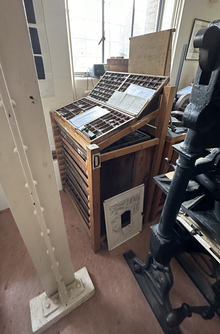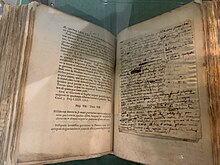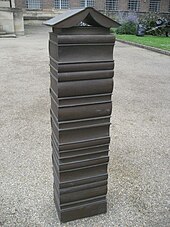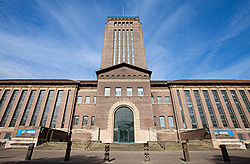|
Cambridge University Library
Cambridge University Library is the main research library of the University of Cambridge. It is the largest of over 100 libraries within the university.[1] The library is a major scholarly resource for members of the University of Cambridge and external researchers. It is often referred to within the university as the UL.[2] Thirty-three faculty and departmental libraries are associated with the University Library for the purpose of central governance and administration, forming "Cambridge University Libraries". Cambridge University Library is one of six legal deposit libraries under UK law.[3] It holds about 9 million items (including maps and sheet music) and, through legal deposit, purchase and donation it receives around 100,000 items every year. The University Library is unique among the legal deposit libraries in keeping a large proportion of its material on open access and in allowing some categories of reader to borrow from its collections. Its original location was the Old Schools near the Senate House until it outgrew the space there. A new library building was constructed in the 1930s. The library took over the site of a former military hospital on the western side of Cambridge city centre, now between Robinson College and the Memorial Court of Clare College. The current building, designed by Giles Gilbert Scott, opened in 1934. The librarian, Jessica Gardner, is the second woman to hold this office.[4] HistoryThe first library By the middle of the 14th century, the University of Cambridge owned a collection of books. These would have been kept in chests along with other valuables, rather than in a library building as would be recognised today.[5] A common university library can be traced to the beginning of the 15th century, with the first direct reference to a 'library'. In March 1416, the will of William Loring was proved, which bequeathed three volumes to the library thus: "Item volo quod omnes libri mei juris civilis remaneant in communi libraria scolarium universitatis Cantebrigg' in perpetuum." In the second decade of the 15th century, the library found a home on the newly built Old Schools site. The earliest catalogue is dated c. 1424, at which time there were 122 volumes in the library.[6] The second earliest surviving catalogue was drawn up in 1473, and records 330 volumes. During the English Reformation, while there does not seem to be evidence of widespread destruction of books, as there was at Oxford, some books were certainly destroyed, and there were very few donations. King's College received only one bequest between 1528 and 1568.[7] From the 16th century, the library received generous donations or bequests of books and growth was considerably increased once the privilege of legal deposit had been granted. In 1648 the House of Commons ordered funds for the library.[8] The library's space was greatly extended with the building of the Cockerell Building on Senate House Passage in 1837–42. The new libraryFollowing an initiative by A. F. Scholfield (librarian from 1923 to 1949), it was decided to build a larger facility. The site selected comprised the 8 acres (3.2 ha) joint cricket field of King's and Clare Colleges. During the First World War, a large part of the site had been requisitioned by the War Office to create the 1st Eastern General Hospital, a facility for the Royal Army Medical Corps to treat military casualties.[9] The hospital had 1,700 beds at its height and treated some 70,000 casualties between 1914 and 1919.[10] The new University Library building was designed by Giles Gilbert Scott, who also designed the neighbouring Clare Memorial Court (part of Clare College). It was constructed between 1931 and 1934. It is a Grade II listed building.[11] Inside are a number of 17th and 18th century bookcases including those designed for the old University Library by James Essex in 1731–34.[12] The funds for the new library were raised by colleges and from private donors. The American philanthropist John D. Rockefeller provided the largest part of the funds for the library's construction. Sensing that it needed a grander entrance, Rockefeller persuaded the architect to add the distinctive front-facing tower.[13] The tower can be seen for several miles around Cambridge.[13] The bronze main entrance and the aluminium bronze screens to the reading room were made by H. H. Martyn & Co.. The building bears a resemblance to Scott's industrial architecture, including Bankside Power Station (now Tate Modern). The library tower stands 157 feet (48 m) tall, 6 feet (1.8 m) shorter than the top of St John's College Chapel and 10 feet (3.0 m) taller than the peak of King's College Chapel. Supposedly, in opening the building, Neville Chamberlain referred to it as "this magnificent erection". Contrary to popular belief, pornographic material is not stored in the tower.[14] The library has been extended several times through ground annexes and underground extensions which allowed for new legal deposit documents to be stored. The main building houses the Japanese and Chinese collections in the Aoi Pavilion, an extension donated by Tadao Aoi and opened in 1998. The University Library has also built a large storage facility in Ely which has more than 100 kilometres of shelving for future legal deposit books and periodicals. Work on a £17.1 million off-site facility to house the growing collection finished in 2018 and provides Cambridge University with one of the largest library storage buildings in the world.[15] Legal deposit libraryCambridge University Library is one of the six legal deposit libraries under UK law, the others being the British Library, the National Library of Scotland, the National Library of Wales, the Bodleian Libraries, Oxford, and the Library of Trinity College, Dublin.[3] Although the Irish Free State left the UK in 1922, Trinity College Dublin remains a UK deposit library and the UK libraries reciprocally retain deposit rights for Irish publications.[16][17] As a legal deposit library, the University Library is entitled to claim without charge a copy of all books, journals, printed maps and music published in the United Kingdom and Ireland. This has contributed to the library's large holdings of over seven million books and 1.5 million periodicals. Between 800 and 1200 books a week are received through legal deposit. From 6 April 2013, legal deposit also covers material published digitally and online, so that the Legal Deposit libraries can provide a national archive of the UK's non-print published material, such as websites, blogs and ejournals. Significant digitisation efforts continue as more manuscripts and early-modern books are acquired and scanned by the University of Cambridge.  AccessThe library is open to all members of the University of Cambridge. As is traditional among British university libraries, postgraduates and academics from other UK universities are allowed reference-only access to the library's collection, and members of the public may apply for access to use the Library for reference if their research requires access to materials held there. Students and academics from other libraries and institutions must submit a request for access before using the facilities in Cambridge. The library is unique among the UK's legal deposit libraries in keeping a large proportion of its books on open access and in allowing some categories of reader (for example Cambridge academics, postgraduates and undergraduates) to borrow from its collection. It has a Tea Room in which meals, snacks and beverages are available. The library regularly puts on exhibitions, free to the public, and featuring items from its collections. JanusIn 2002, the library began a special project termed Janus (after the Roman god) to provide a single point of networked access to catalogues of archives and manuscript collections held throughout Cambridge. This is a major development for the Cambridge Universities Libraries, especially because Cambridge is home to more than 100 libraries and research institutes, each with their own mandate and organisational structure. A widening number of participating repositories, both University and non-University, are working together to provide comprehensive coverage of archives in the city and surrounding area. While it was running, Janus could be accessed by students and members of university both online and in-person.[18] At the beginning of March 2021, Janus was decommissioned[19] and replaced by ArchiveSearch, an index of archives and finding aids for most of the archives in the city of Cambridge, including
Historical Printing Room In addition to archives for some major figures in the history of typography and printing (Stanley Morison, Frances Meynell, etc), the Library hosts the Historical Printing Room.[20] In the early 1970s, Philip Gaskell as the Librarian of Trinity College set up a bibliographical teaching press similar to those at the Bodleian, University College London, and other institutions. The idea was to permit students to experience the historical process of letterpress printing themselves so they could better understand early book structure and the activities necessary to produce books. Classes began in 1974 and have continued to the present day. Equipment in the HPR include Philip Gaskell's own Albion iron hand press, a small etching press, paper moulds made for William Morris, and other equipment donated by Cambridge University Press. Research at the HPR is supported by significant archives at the CUL, including the Broxbourne collection of type specimens,[21] the Chapbooks collection, and extensive archives of eminent printers.[22] Digitisation project In June 2010, Cambridge University announced that a £1.5 million donation would allow them to start digitising some of the collections in the University Library and eventually provide access to them free of charge over the Internet via the Cambridge Digital Library website. Initially the project will focus on two collections called "The Foundations of Faith" and "The Foundations of Science", which includes writings by Isaac Newton and his contemporaries, as well as documents from the Library's archives of Christian, Islamic and Jewish texts. Friends of the Cambridge University LibraryThe Friends of the Cambridge University Library was established by a group of individuals, organisations and private donors who are committed to supporting the growth and development of the library. Members of the Friends regularly raise funds for future construction projects and archival restoration efforts, as well as the acquisition and purchase of rare books or manuscripts. Membership in the group is open to all alumni and members of the public interested in the preservation of knowledge and literature. Special events and tours are organised to recognise the contribution of the membership. The Friends of the Cambridge University Library has raised more than £150,000 through regular and special donations over the past five years.[23] Staff The official office of Librarian of the university was not established until 1577, when William James was appointed Librarian. The first set of regulations "for the Office of keeping the Library" were then formed in 1582.[24] Little is known of the administration before the late sixteenth century. Before 1577, the University Chaplain had overall responsibility of the Library among other duties. Sixteen potential Chaplain-Librarians have been identified.[24] In 1721 the post of Principal Librarian (Protobibliothecarius) was created for Conyers Middleton "as a mark of sympathy with him in his opposition to Richard Bentley".[25] In 1828 this post was merged with that of Librarian (Bibliothecarius). Various scholars have held the position. Abraham Wheelocke was librarian of the "Public Library" at Cambridge University, and was also Reader in Anglo-Saxon in the 17th century. Augustus Theodore Bartholomew was a librarian at Cambridge University for over 25 years. The classicist A. F. Scholfield was Librarian from 1923 to 1949. More recent University Librarians have included Eric Bertrand Ceadel, F. W. Ratcliffe (1980–94), Peter Fox (1994–2009) and Anne Jarvis (2009–16). Other notable members of staff include the bibliographer Henry Bradshaw and the Uranian poet Charles Edward Sayle, author of a history of the library. The current librarian is Jessica Gardner.[26] She joined the library in April 2017, becoming the 36th University Librarian. ExhibitionsThe main University Library hosts exhibitions in its purpose-built Milstein Exhibition Centre. These change approximately every six to eight months and are open to all. Recent exhibitions have highlighted Cambridge's significant collection of documents from the Cairo Genizah, the landscape and geology of the English Fenlands, and the architectural history of the Cambridge University. The exhibitions are sponsored by the Cambridge University Library and are organised by the team of librarians and leading academics in the field. Entry to the exhibitions is always free and open to the general public. Special collections  As part of its collection[27] of more than 8,000,000 volumes, the library contains a wealth of printed and manuscript material from earlier times. This includes:
Cultural references
See also
References
Bibliography
Descriptions of collections
External linksWikimedia Commons has media related to Cambridge University Library.
|
||||||||||||||||||||||||||||||||||



